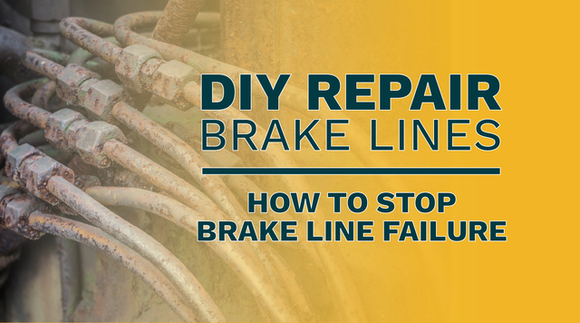
How to Spot Brake Line Failure: Warning Signs and What to Do Next
How to Spot Brake Line Failure: Warning Signs and What to Do Next
Brakes aren’t just another system on your vehicle—they’re the one that can’t afford to fail. Your brake lines deliver hydraulic pressure to the brakes at each wheel, and when they start to corrode, leak, or weaken, you’re putting your safety on the line.
Knowing how to recognize the early warning signs of brake line failure can help you act before it becomes a serious hazard. Let’s walk through what to look for, what causes these issues, and how to fix them the right way.
Common Signs of Brake Line Failure
Soft or Spongy Brake Pedal
If your brake pedal feels soft or sinks to the floor, air or moisture might have entered the brake line. This can happen when the line corrodes or develops a small leak, allowing air bubbles to reduce hydraulic pressure.
What to do: Don’t ignore it. Have your brake system inspected immediately—if fluid is escaping, your stopping power is already compromised.
Visible Fluid Leaks Near the Wheels or Undercarriage
Brake fluid leaks are one of the clearest signs of a failing brake line. You might notice wet spots near your tires, under the vehicle, or along the frame where the lines run. Brake fluid usually appears clear to amber-colored and slightly slick to the touch.
What to do: If you spot a leak, top off fluid only to get home or to a mechanic—it’s not a long-term fix. Once a line is leaking, replacement is the only safe solution.
Rust or Corrosion on Brake Lines
In northern climates, road salt is a brake line’s worst enemy. Steel lines corrode over time, especially where they’re exposed to moisture and salt. Even small patches of rust can quickly expand into pinhole leaks.
What to do: Inspect lines regularly, especially before and after winter. If rust is visible, plan for replacement soon—preferably with a corrosion-resistant material.
Uneven Braking or Pulling to One Side
When one line fails or a wheel cylinder isn’t getting enough pressure, your vehicle might pull to one side under braking. This isn’t just uncomfortable—it’s a serious safety issue that signals uneven hydraulic distribution.
What to do: Don’t keep driving like this. A failed line or seized brake could lead to total loss of braking on one side of your vehicle.
What Causes Brake Line Failure?
Brake line failure often comes down to three culprits:
Corrosion: Moisture and road salt gradually eat away at steel lines.
Physical Damage: Rocks, debris, or improper jacking can nick or bend lines.
Aging Materials: Over time, even the best factory steel lines lose integrity.
The good news? There’s a modern solution that resists all three problems: copper-nickel brake lines.
Why Copper-Nickel Brake Lines Are the Best Fix
When replacing old or damaged brake lines, copper-nickel tubing (also called CuNi or NiCopp) is the gold standard. It’s used by professional mechanics, restoration experts, and even in aerospace applications for a reason.
Here’s why:
Corrosion Resistance: Copper-nickel doesn’t rust or pit like steel. It holds up for decades, even in harsh climates.
Flexibility: It bends easily by hand, making installation simple and precise—no need for expensive tools.
Durability: It meets all SAE and ISO brake line standards while offering a longer service life.
Appearance: The copper finish not only looks great but helps you easily inspect for damage or wear.
If you’re looking for an upgrade that outlasts the life of your vehicle, copper-nickel brake lines are the way to go.
Shop our Copper-Nickel Brake Line Coils or explore complete Brake Line Replacement Kits to get everything you need for a long-lasting, rust-proof brake system.
When to Replace or Repair
If your brake lines show any of these signs—leaking, cracking, or visible rust—it’s time to replace them. Repairing sections might seem cheaper upfront, but mixing old steel with new sections often leads to recurring problems.
Instead, consider a full replacement with copper-nickel lines for peace of mind and long-term reliability.
Pro Tip: Even if your lines look okay, replace them every 10–15 years (or sooner in salty climates). It’s one of the simplest ways to protect your entire brake system.
Final Thoughts: Don’t Wait on Brake Safety
Brake line failure rarely happens overnight—it’s a gradual process that gives you warning signs along the way. Pay attention to those signs, inspect regularly, and when it’s time to replace, choose materials that keep you safe for the long haul.
Copper-nickel brake lines offer the perfect balance of strength, corrosion resistance, and ease of installation—making them the smart, safe choice for every driver and DIYer.
Ready to upgrade your brake system?
Explore 4LifetimeLines’ full lineup of Copper-Nickel Brake Line Coils and Kits and drive with confidence knowing your brake system is built to last.
